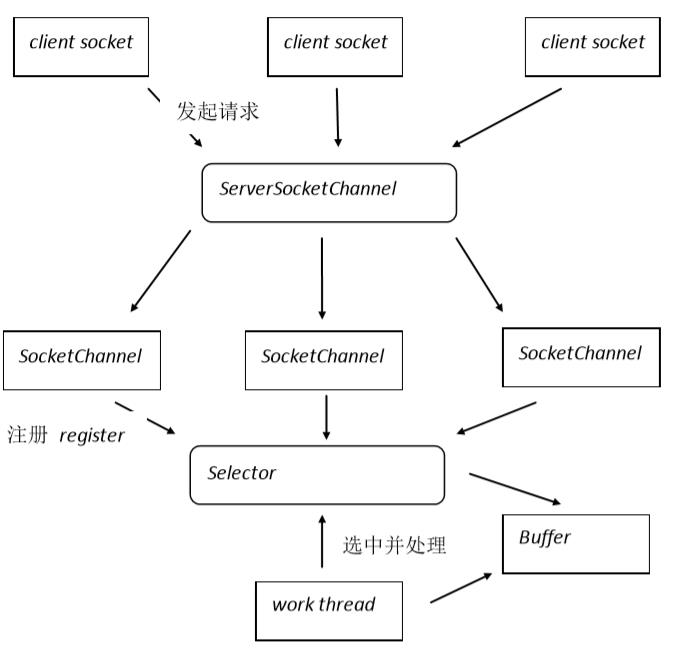javaNIO编程
Posted 石
tags:
篇首语:本文由小常识网(cha138.com)小编为大家整理,主要介绍了javaNIO编程相关的知识,希望对你有一定的参考价值。
Unblocking IO(New IO): 同步非阻塞的编程方式
NIO 本身是基于事件驱动思想来完成的,其主要想解决的是 BIO 的大并发问题,NIO 基 于 Reactor,当 socket 有流可读或可写入 socket 时,操作系统会相应的通知引用程序进行处 理,应用再将流读取到缓冲区或写入操作系统。也就是说,这个时候,已经不是一个连接就 要对应一个处理线程了,而是有效的请求,对应一个线程,当连接没有数据时,是没有工作 线程来处理的。
NIO 的最重要的地方是当一个连接创建后,不需要对应一个线程,这个连接会被注册到 多路复用器上面,所以所有的连接只需要一个线程就可以搞定,当这个线程中的多路复用器 进行轮询的时候,发现连接上有请求的话,才开启一个线程进行处理,也就是一个请求一个 线程模式
在 NIO 的处理方式中,当一个请求来的话,开启线程进行处理,可能会等待后端应用的 资源(JDBC 连接等),其实这个线程就被阻塞了,当并发上来的话,还是会有 BIO 一样的问题。

同步非阻塞,服务器实现模式为一个请求一个通道,即客户端发送的连接请求都会注册 到多路复用器上,多路复用器轮询到连接有 I/O 请求时才启动一个线程进行处理。 NIO 方式适用于连接数目多且连接比较短(轻操作)的架构,比如聊天服务器,并发局 限于应用中,编程复杂,JDK1.4 开始支持。
Buffer:ByteBuffer,CharBuffer,ShortBuffer,IntBuffer,LongBuffer,FloatBuffer,DoubleBuffer
Channel:SocketChannel,ServerSocketChannel 。
Selector:Selector,AbstractSelector SelectionKey:OP_READ,OP_WRITE,OP_CONNECT,OP_ACCEPT
import java.io.IOException;
import java.net.InetSocketAddress;
import java.nio.ByteBuffer;
import java.nio.channels.SocketChannel;
import java.util.Scanner;
public class NIOClient {
public static void main(String[] args) {
// 远程地址创建
InetSocketAddress remote =new InetSocketAddress("localhost", 9999);
SocketChannel channel = null;
// 定义缓存
ByteBuffer buffer =ByteBuffer.allocate(1024);
try {
// 开启通道
channel=SocketChannel.open();
// 连接远程服务器。
channel.connect(remote);
Scanner reader = new Scanner(System.in);
while(true){
System.out.print("put message for send to server > ");
String line = reader.nextLine();
if(line.equals("exit")){
break;
}
// 将控制台输入的数据写入到缓存。
buffer.put(line.getBytes("UTF-8"));
// 重置缓存游标
buffer.flip();
// 将数据发送给服务器
channel.write(buffer);
// 清空缓存数据。
buffer.clear();
// 读取服务器返回的数据
int readLength=channel.read(buffer);
if(readLength==-1) break;
// 重置缓存游标
buffer.flip();
byte[] datas=new byte[buffer.remaining()];
// 读取数据到字节数组。
buffer.get(datas);
System.out.println("from server : " + new String(datas, "UTF-8"));
// 清空缓存。
buffer.clear();
}
} catch (IOException e) {
e.printStackTrace();
}finally{
if(null != channel){
try {
channel.close();
} catch (IOException e) {
e.printStackTrace();
}
}
}
}
}
import java.io.IOException; import java.net.InetSocketAddress; import java.nio.ByteBuffer; import java.nio.channels.CancelledKeyException; import java.nio.channels.SelectionKey; import java.nio.channels.Selector; import java.nio.channels.ServerSocketChannel; import java.nio.channels.SocketChannel; import java.util.Iterator; import java.util.Scanner; public class Nioservice implements Runnable { // 多路复用器, 选择器。 用于注册通道的。 private Selector selector; // 定义了两个缓存。分别用于读和写。 初始化空间大小单位为字节。 private ByteBuffer readBuffer = ByteBuffer.allocate(1024); private ByteBuffer writeBuffer = ByteBuffer.allocate(1024); public static void main(String[] args) { new Thread(new NioService(9999)).start(); } public NioService(int port){ init(port); } private void init(int port){ try { System.out.println("server starting at port " + port + " ..."); // 开启多路复用器 this.selector=Selector.open(); // 开启服务通道 ServerSocketChannel serverChannel =ServerSocketChannel.open(); // 非阻塞, 如果传递参数true,为阻塞模式。 serverChannel.configureBlocking(false); // 绑定端口 serverChannel.bind(new InetSocketAddress(port)); // 注册,并标记当前服务通道状态 /* * register(Selector, int) * int - 状态编码 * OP_ACCEPT : 连接成功的标记位。 * OP_READ : 可以读取数据的标记 * OP_WRITE : 可以写入数据的标记 * OP_CONNECT : 连接建立后的标记 */ serverChannel.register(this.selector, SelectionKey.OP_ACCEPT); System.out.println("server started."); } catch (IOException e) { e.printStackTrace(); } } public void run(){ while(true){ try { // 阻塞方法,当至少一个通道被选中,此方法返回。 // 通道是否选择,由注册到多路复用器中的通道标记决定。 this.selector.select(); // 返回以选中的通道标记集合, 集合中保存的是通道的标记。相当于是通道的ID。 Iterator<SelectionKey> keys = this.selector.selectedKeys().iterator(); while(keys.hasNext()){ SelectionKey key = keys.next(); // 将本次要处理的通道从集合中删除,下次循环根据新的通道列表再次执行必要的业务逻辑 keys.remove(); // 通道是否有效 if(key.isValid()){ // 阻塞状态 try{ if(key.isAcceptable()){ accept(key); } }catch(CancelledKeyException cke){ // 断开连接。 出现异常。 key.cancel(); } // 可读状态 try{ if(key.isReadable()){ read(key); } }catch(CancelledKeyException cke){ key.cancel(); } // 可写状态 try{ if(key.isWritable()){ write(key); } }catch(CancelledKeyException cke){ key.cancel(); } } } } catch (IOException e) { e.printStackTrace(); } } } private void write(SelectionKey key){ this.writeBuffer.clear(); SocketChannel channel =(SocketChannel) key.channel(); Scanner reader=new Scanner(System.in); try { System.out.print("put message for send to client > "); String line=reader.nextLine(); // 将控制台输入的字符串写入Buffer中。 写入的数据是一个字节数组。 writeBuffer.put(line.getBytes("UTF-8")); writeBuffer.flip(); channel.write(writeBuffer); channel.register(this.selector, SelectionKey.OP_READ); } catch (Exception e) { // TODO: handle exception } } private void read(SelectionKey key){ try { // 清空读缓存。 this.readBuffer.clear(); //获取通道 SocketChannel channel =(SocketChannel)key.channel(); // 将通道中的数据读取到缓存中。通道中的数据,就是客户端发送给服务器的数据。 int readLength =channel.read(readBuffer); // 检查客户端是否写入数据。 if(readLength==-1){ // 关闭通道 key.channel().close(); // 关闭连接 key.cancel(); return; } /* * flip, NIO中最复杂的操作就是Buffer的控制。 * Buffer中有一个游标。游标信息在操作后不会归零,如果直接访问Buffer的话,数据有不一致的可能。 * flip是重置游标的方法。NIO编程中,flip方法是常用方法。 */ this.readBuffer.flip(); // 字节数组,保存具体数据的。 Buffer.remaining() -> 是获取Buffer中有效数据长度的方法。 byte[] datas=new byte[readBuffer.remaining()]; // 是将Buffer中的有效数据保存到字节数组中。 readBuffer.get(datas); System.out.println("from " + channel.getRemoteAddress() + " client : " + new String(datas, "UTF-8")); // 注册通道, 标记为写操作。 channel.register(this.selector, SelectionKey.OP_WRITE); } catch (IOException e) { e.printStackTrace(); try { key.channel().close(); key.cancel(); } catch (IOException e1) { e1.printStackTrace(); } } } private void accept(SelectionKey key){ try { // 此通道为init方法中注册到Selector上的ServerSocketChannel ServerSocketChannel serverChannel =(ServerSocketChannel)key.channel(); // 阻塞方法,当客户端发起请求后返回。 此通道和客户端一一对应。 SocketChannel channel = serverChannel.accept(); channel.configureBlocking(false); // 设置对应客户端的通道标记状态,此通道为读取数据使用的。 channel.register(this.selector, SelectionKey.OP_READ); } catch (IOException e) { e.printStackTrace(); } } }
/**
*
* Buffer的应用固定逻辑
* 写操作顺序
* 1. clear()
* 2. put() -> 写操作
* 3. flip() -> 重置游标
* 4. SocketChannel.write(buffer); -> 将缓存数据发送到网络的另一端
* 5. clear()
*
* 读操作顺序
* 1. clear()
* 2. SocketChannel.read(buffer); -> 从网络中读取数据
* 3. buffer.flip() -> 重置游标
* 4. buffer.get() -> 读取数据
* 5. buffer.clear()
*
*/
public class TestBuffer {
public static void main(String[] args) throws Exception {
ByteBuffer buffer = ByteBuffer.allocate(8);
byte[] temp = new byte[]{3,2,1};
// 写入数据之前 : java.nio.HeapByteBuffer[pos=0 lim=8 cap=8]
// pos - 游标位置, lim - 限制数量, cap - 最大容量
System.out.println("写入数据之前 : " + buffer);
// 写入字节数组到缓存
buffer.put(temp);
// 写入数据之后 : java.nio.HeapByteBuffer[pos=3 lim=8 cap=8]
// 游标为3, 限制为8, 容量为8
System.out.println("写入数据之后 : " + buffer);
// 重置游标 , lim = pos ; pos = 0;
buffer.flip();
// 重置游标之后 : java.nio.HeapByteBuffer[pos=0 lim=3 cap=8]
// 游标为0, 限制为3, cap为8
System.out.println("重置游标之后 : " + buffer);
// 清空Buffer, pos = 0; lim = cap;
// buffer.clear();
// get() -> 获取当前游标指向的位置的数据。
// System.out.println(buffer.get());
/*for(int i = 0; i < buffer.remaining(); i++){
// get(int index) -> 获取指定位置的数据。
int data = buffer.get(i);
System.out.println(i + " - " + data);
}*/
}
}
以上是关于javaNIO编程的主要内容,如果未能解决你的问题,请参考以下文章